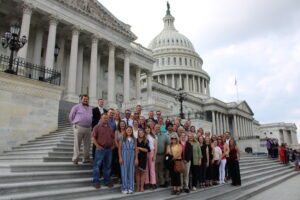 By Theresa Sweeney-Murphy, Senior Director, Communications & Outreach
By Theresa Sweeney-Murphy, Senior Director, Communications & Outreach
This year marks a major milestone for the National Milk Producers Federation’s (NMPF) National Young Cooperators (YC) Program as it celebrates its 75th anniversary. Young dairy farmer leaders from across the country are gathered this week in Washington, D.C. to engage with lawmakers, advocate for key dairy issues and continue building the next generation of cooperative leadership.
The multi-day program is a hallmark event for NMPF, providing young cooperators with in-depth insights into current policy issues from subject matter experts. Attendees also receive training in relationship-building with lawmakers, message development and effective communication strategies — skills they then have the opportunity to apply during meetings with members of Congress and their staffs on Capitol Hill.
Drawing from their own experiences, young cooperators will highlight the effects of policy action — and inaction — on their farms during meetings with policymakers. A key priority this year is pushing for agricultural labor reform that provides dairy farmers with access to a stable, legal workforce. They will also advocate for the Whole Milk for Healthy Kids Act, underscoring the nutritional benefits of whole milk for children, and champion efforts to expand reliable export markets for U.S. dairy products.
Now celebrating the 75th year, the YC Program remains firmly rooted in the cooperative values that bring the dairy community together. Since 1950, it has helped shape the next generation of leaders by offering year-round leadership training and educational opportunities for young farmers looking to step into greater roles — on their farms, in their cooperatives, and throughout the industry.
This week’s event reinforces the critical role the YC Program plays in dairy farmer advocacy. As challenges grow more complex, having well-prepared, informed young leaders at the table is more important than ever. Their voices bring real-world insight to policy discussions, ensuring that dairy farmers’ needs are heard and understood by policymakers. Their involvement is essential to shaping sound policies and securing a strong future for the industry.
Beyond this week’s Dairy Policy and Legislative Forum in Washington, the YC Program has more in-person events planned for 2025. Educational sessions will be held October 2 and 3 at World Dairy Expo in Madison, Wis., followed by the annual Leadership and Development Program, taking place November 9 to 12 in Arlington, Texas.
The National YC Program is open to dairy farmers under the age of 45 who own or work on a farm that’s part of an NMPF member cooperative. To stay informed about upcoming events and opportunities, click here and check the National YC Program box. You can also reach out to your cooperative to learn more about getting involved.

This column originally appeared in Hoard’s Dairyman Intel on June 9, 2025.









